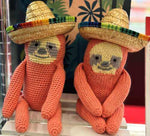*** Free UK delivery on orders over £75 ***
Menu
-
- New
-
Yarn
- Stitching
-
Hooks & Needles
-
Accessories
-
All Accessories
- Blocking
- Books and Magazines
- Buttons
- Cable Needles
- Chart Keepers
- Darning Needles and Pins
- Needle and Hook Cases
- Notebooks and Stationery
- Pom Poms
- Row Counters
- Rulers and Needle Gauges
- Scissors
- Sewing
- Stitch Holding Cords
- Stitch Markers
- Stitch Stoppers
- Swifts and Winders
- Wool Wash
- Yarn Bowls
- Yarn Snugs
- Other
- Bags
- Brands
-
All Accessories
-
Patterns & Kits
-
Gifts
- Sale
-
How to & Ideas
-
- Login

*** Free UK delivery on orders over £75 ***
Yarn Weights: What Is Worsted Weight Yarn?
February 26, 2021 5 min read

A complete guide to Yarn Weights & Worsted Weight Yarn
Sometimes yarn terminology can really make your head spin! That's why we've put together this guide about one of the most common yarn terms: worsted weight. This term originated in the US, but worsted weight yarn has become increasingly popular in the UK and other countries. Essentially, it's a medium weight yarn that's a versatile choice for many projects, from jumpers to mittens.
Contents:
- Worsted weight yarn equivalents
- Yarn weights
- Choosing the right needles
- Worsted weight vs DK
- A quick guide to plies
- Fibres in worsted weight yarn
What is the UK equivalent of worsted weight yarn?
If you've only started to hear about worsted weight in recent years, don't worry. It's not a traditionally British term. This term has increased in popularity, largely thanks to the internet bringing the international yarn community together. So what is worsted weight yarn in UK terms?
Aran vs Worsted Wool
Historically, the UK worsted weight yarn equivalent has been aran. Some serious yarn enthusiasts will tell you that these terms aren't precisely interchangeable. That's because traditionally, worsted and aran yarns were spun differently. As a result, true aran yarn has more loft and a bouncier feel than worsted. However, most modern knitting companies don't differentiate between the two.
Aran yarn is also known as 10 ply yarn. It's important to note that in Australia, 10 ply yarn is commonly referred to as the equivalent of worsted weight yarn. So, if you're working on a pattern from Down Under and uncertain about which yarn to use, remember that 10 ply yarn is what you'll need.
What weight is worsted weight yarn?
When we refer to yarn weight, we're not talking about how heavy it is. Confused? Fear not - it's pretty simple to understand. Yarn weight actually refers to its thickness, and is key to the success of any project. The physical weight is another matter. You'll find some fibres, such as alpaca or silk, are lighter than wool or cotton regardless of thickness.
Before you cast on any pattern, check out which yarn weight it was designed for. You might be able to substitute between weight classes, but this is not recommended for new knitters. Trying to knit a blanket from a laceweight yarn would be a long and frustrating process. Equally, socks made with chunky yarn are unlikely to fit into your shoes!
We tend to judge yarn weight according to tension or gauge - that is to say, the number of stitches that will make up 4" if you are simply knitting in stocking stitch. Here are the most common yarn weights you're likely to see. Terminology can change between countries:

Which size needles should be used with worsted weight yarn?
Most projects using worsted yarn will use needles between 4.5 and 5.5 mm. This will give you a fabric that is firm but not too tight. You can expect to see no holes or gaps between stitches. This is the needle size you're most likely to use if you're making jumpers, cardigans or scarves. Pieces with cable designs or Fair Isle colourwork will probably fall into this category.
The nature of your project may affect the size of needle that you use. For example, if you want to make a shawl with a lace motif, you will probably use a larger needle, up to 8 mm. This will give the fabric a lighter, airier feel, and will clearly show gaps between stitches. If you're wearing a jumper made with larger needles, you'll probably want to make sure you've got something on underneath!
Some projects require a tighter tension. For example, if you're using cotton yarn to make face cloths, you'll want a stiffer fabric, so you'll probably use a needle size of around 4 mm or even smaller.
When you're working from a pattern, always check the gauge before you start. Knit a gauge swatch and compare your stitch count to what the pattern says. Some of us naturally knit looser or tighter, so you may need to change your needle size to meet gauge. For some projects - scarves, for example - gauge is not crucial. Others, like jumpers, cardigans or hats, really need gauge to accurate. Think of how long it takes to knit a jumper. That's a lot of time to waste on something that doesn't fit!

Is worsted weight yarn the same as DK?
No. Worsted is thicker than DK. Worsted is sometimes known as 10 ply yarn, while DK is referred to as 8 ply. These terms aren't totally accurate (the number of plies a yarn contains varies according to the spinner - something that can get quite technical). They're good to keep in mind, though, as they give you a general idea of yarn weight.
Although DK is lighter than worsted, they are both considered to be medium weight yarns, and they're often used for the same kind of projects. You might be able to substitute one for the other, but always knit a gauge swatch first.
What is a ply?
The term ply can be quite confusing. That's because we use it in two different ways. First, ply can refer to the weight of a yarn. Secondly, it's used to define how yarn is spun.
We've already talked about yarn weight, so you know that worsted is also known as 10 ply. In spinning terms, though, worsted can have any ply count! For spinners, a ply is a single strand of yarn. Look closely at the yarn you're using: you might see several fibres wrapped around each other. These are plies.
Generally, a higher ply count suggests that a yarn will be longer-lasting and less likely to pill. Single-ply yarns can be very attractive, but they're usually best for garments like scarves, shawls or cowls; use one for a jumper and it may start to pill very quickly. Yarns with four or more plies are a better choice for making garments that will last.
What is worsted weight yarn made from?
Worsted weight yarn can be made from a wide range of fibres- wool, cotton, alpaca, acrylic and many more.
For new knitters working from a pattern, it's usually a good idea to stick close to the suggested yarn. If you substitute cotton for wool, you might find that your finished project is very different from what you expected. Notice that some yarns have particular properties, too: alpaca, for example, has a fuzzy halo effect that is very distinctive. Merino wool is soft and will feel better against your skin than regular wool, which can be itchy.
As you grow more experienced with knitting or crochet, you'll learn to recognise the different properties of particular fibres.
Subscribe to this blog's RSS feed using https://www.yarnworx.com/blogs/yarn-guides.atom
Also in Yarn Guides

What is boucle yarn?
March 21, 2025 2 min read
Boucle yarn is a popular material for knitting that creates a unique textured fabric. Learn everything you need to know about boucle with our in depth guide!

How to crochet a magic circle
May 19, 2023 4 min read

5% off your first order when you join our email newsletter...
Be the first to know of new product releases and other exciting news! A discount code will be sent to your email straight away!



